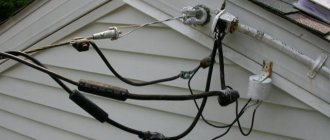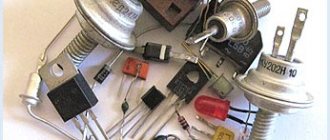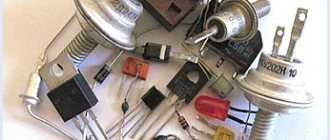The concept of a natural phenomenon called “static electricity” is known to most people from a school physics course. It describes an experience when finely chopped pieces of paper begin to stick to a comb or ebonite stick rubbed against hair. The phenomenon under study is presented in this example as the attraction of dissimilarly charged elements, which is explained by the separation of charges due to the friction work done. However, there are other manifestations of this effect in nature that are not at all similar to an experiment or entertainment experience. Having become familiar with them, it is easier to understand what static voltage is and how it can be dealt with at work and in everyday life.
The appearance and danger of static electricity
The cause of electrification can also be induction.
An electric charge with an opposite value appears on the metal surface, the density of which is uniform in all places. The conditions for this phenomenon to occur can be very different. Often the cause is the pumped liquid moving through pipelines or in the form of a falling jet. The same effect is achieved by compressed or liquefied gases, the operation of belt drives, grinding and processing of organic and polymeric materials. Electrification of dielectric materials often reaches a potential difference with high voltage. For example, during the process of pumping gasoline using a pipeline with an isolated section, electrical potentials can fluctuate between 1460 and 14600 volts.
The accumulation of static electricity is a serious danger. In such cases, a strong spark discharge often appears. The released spark energy with a value of 0.01 J is already capable of causing a fire and explosion. A voltage of 300 volts results in an air spark discharge. Taking timely special measures helps prevent the consequences of electrical discharges.
"Corona" discharge
The industrial experience of the last century testified mainly to the negative effects of “electricity from friction.” Without knowing it, engineers built electrostatic generators of enormous size and, alas, quite high efficiency. We say “alas” because their effectiveness was confirmed by violent explosions in gunpowder factories, flour mills and sugar factories.
It turns out that it is impossible to transport sugar, flour or any dry powder in general through pipes or conveyors without them accumulating an electrical charge. Leather and rubberized belts on rotating pulleys are also electrified to a very high voltage. Paper, fabrics, rubber cords and tapes - and they are highly electrified during processing. And if there is fine flammable dust hanging in the air - say, flour or powdered sugar - then a spark that jumps from an electrified body can cause an explosion.
Material on the topic: how to determine current power.
The 20th century incredibly expanded the scope of harmful manifestations of electrostatic electricity. Countless plastics, artificial and synthetic fibers, varnishes and paints, oil, petroleum products and other electrifying liquids - this is not a complete list.
It will be interesting➡ What is a Faraday cage
Airplanes are electrified during flight. Oil is electrified during pumping through pipelines, even steam is electrified during the process of evaporation and movement through pipes. Therefore, in our century, the attention of specialists was initially aimed mainly at reducing the efficiency of accidental electrostatic generators and getting rid of electrification and its unpleasant consequences. And in addition to moisturizing the materials being processed, methods of air ionization appear - radioactive isotopes and corona discharge.
If a voltage exceeding 30 thousand V is applied to two plates separated by a centimeter gap, a breakdown occurs - a spark jumps, the air ceases to be an insulator and becomes a conductor. What happens if you apply a negative voltage of 100 thousand V to a wire passing through the center of a grounded cylinder with a radius of 10 cm?
At first glance, nothing should happen: after all, for every centimeter of space separating the wire and the cylinder, there are not 30 thousand V required for a breakdown, but only 10 thousand.
This would be the case if we were talking about parallel plates creating a uniform electric field in the gap. A thin wire in a cylinder creates a non-uniform field; near the walls of the cylinder it is weaker, and in the area adjacent to the wire, a voltage of more than 30 thousand V may occur per 1 cm.
The electrons that escape from the surface of the wire are embedded in oxygen molecules and turn them into negatively charged ions, rushing to the walls of the cylinder under the influence of an electric field. At this moment, a greenish glow appears around the wire - a corona discharge. By making the air electrically conductive, such a discharge removes the charge from electrified substances.
This is what it was used for at first. But then it turned out that in such a phenomenon lay the key to the widespread industrial use of static electricity. In 1905, the English inventor F. Cottrell began passing gas contaminated with soot and ash particles through a pipe with a corona discharge. The ions produced in the discharge “stick” to the solid particles and impart a large negative charge to them, after which such particles are quickly thrown back by the electric field onto the walls of the grounded pipe, from which purified gas emerges as a result.
Static field generator
The corona discharge, which made it possible to impart charges to dielectric bodies many times greater than those that could be imparted to them due to friction, gave industrial significance to static electricity. Experiments that were formerly used for entertainment became the basis for important technical devices and processes. Installations have appeared for separating all kinds of bulk mixtures using electrostatics. It has become widely used in printing processes, paper and film processing.
In an electrostatic field, painting is carried out, abrasive particles, dry powders and even short fibers are applied to all kinds of substrates. The electrostatic field and corona discharge are the main participants in the xerographic process for fast text reproduction and non-contact printing methods. This is how “electricity from friction” enters industry and life, which was popular in the second half of the 18th century and which was little studied over the next 150 years. And this rapidly growing practical application of electrostatics is the secret of the increased interest in the electrostatic generators needed to drive all these important technological processes.
Basic parameters of static electricity discharge.
Harm and benefits of static electricity
Many scientists and inventors tried to use static charge. Cumbersome units were created, the benefits of which were low. The discovery of corona discharge by scientists turned out to be useful. It is widely used in industry. Using an electrostatic charge, complex surfaces are painted and gases are purified from impurities. This is all good, but there are also numerous problems. Electric shocks can be very powerful. They can sometimes infect humans. This happens both at home and in the workplace.
The harm of static electricity manifests itself in shocks of varying power when removing a synthetic sweater, getting out of a car, turning on and off a food processor and vacuum cleaner, laptop and microwave oven. These blows can be harmful.
Static electricity occurs, which affects the functioning of the cardiovascular and nervous systems. You should protect yourself from it. The person himself is also often a carrier of charges. When contacting the surfaces of electrical appliances, they become electrified. If this is a control and measuring device, the matter may end in its failure.
The discharge current brought by a person, with its heat, destroys connections, breaks the tracks of microcircuits, and destroys the film of field-effect transistors. As a result, the circuit becomes unusable. Most often, this does not happen immediately, but at any stage during the operation of the tool.
In factories that process paper, plastics, and textiles, materials often behave incorrectly. They stick to each other, stick to various types of equipment, are repelled, collect a lot of dust on themselves, and are wound incorrectly on reels or bobbins. The reason for this is the occurrence of static electricity. Two charges of equal polarity repel each other. Others, one of which is positively charged and the other negatively charged, attract each other. Charged materials behave the same way.
In printing plants and other places where flammable solvents are used, a fire may occur. This occurs when the operator is wearing non-conductive shoes and the equipment is not properly grounded. The ability to ignite depends on the following factors:
- discharge type;
- discharge power;
- static discharge source;
- energy;
- the presence of solvents or other flammable liquids nearby.
Discharges can be spark, hand, or sliding hand. A spark discharge comes from a person. Carpal occurs on pointed parts of equipment. Its energy is so low that it poses virtually no fire hazard. Sliding brush discharge occurs on synthetic sheets, as well as on rolled materials with different charges on each side of the sheet. It poses the same danger as a spark discharge.
Lethality is a major issue for safety experts. If a person holds on to the bobbin and is in the tension zone, his body will also be charged. To remove the charge, be sure to touch ground or grounded equipment. Only then will the charge go into the ground. But the person will receive a strong or weak electric shock. The result is reflexive movements that sometimes lead to injury.
A long stay in a charged zone leads to a person’s irritability, decreased appetite, and poor sleep.
Dust is removed from the production area using ventilation. It accumulates in pipes and can ignite from a static spark discharge.
Scope of use
Electrostatic instruments and devices, the operating principle of which was based on friction, were never able to leave laboratory and educational shelves, where they are mainly used as demonstration material.
Attempts to use static fields to generate electric current also did not bring much success. Van Der Graaff and Felici generators, which were created in the 30th and 40th years of the last century, also did not find wide application, because this equipment was quite cumbersome.
Van Der Graaff Generators
In addition, their operation and maintenance were very expensive.
The discovery of corona discharge, which is widely used in various fields of industry, turned out to be very useful from the point of view of industrial application. In particular, with its help, you can purify gases from various impurities and apply paint to a surface of any configuration.
Unpleasant static electricity and protection against it
Let's talk about how to protect yourself at work, at home or while traveling by car.
What you need to know:
- First of all, we should talk about air humidification. There is a condition: you cannot install humidifiers in close proximity to electrical appliances, because in this case the humidifiers turn into causes of short circuits, which is even more dangerous.
- When refueling a car, protection is to ensure that no one leaves the car and no one gets into the car. This caution is explained by the fact that movements of this kind cause tension. If the current comes into contact with a flammable liquid, it will cause a strong explosion;
- In everyday life, you can also use antistatic agents to combat electrical charges from rugs, carpets and vacuum cleaners.
Now there are means aimed at removing static from plastic, from car seat upholstery, from electrical appliances that are capable of delivering a high-voltage static current.
Ensuring the safety of your home and apartment
Free electric charge is accumulated by: rubber shoes, synthetic clothing, linoleum and plastic, carpets, reinforced concrete walls. To protect residential premises, you first need to ensure that the air humidity is at least 60%.
- Use grounding and grounding of electrical wiring in residential premises.
- Get rid of dust and prevent it from accumulating on carpets.
- Follow electrical safety rules.
- Treat synthetic clothing with antistatic agent.
Protection against free electrical charges will help preserve health, avoid explosions and fires, and improve the operation of technological devices and electronic devices. These measures are very important both for the protection of each home and for the safety and improvement of conditions for workers at work.
Determination of static electricity
According to the definition, static electricity as an effect is a dangerous phenomenon that threatens the health and practical activities of any person. To comprehend and understand its nature, we should remember that all known substances consist of molecules, and the latter are made of tiny particles called atoms. At their center is a nucleus with protons and neutrons, and groups of electrons rotate around it in different orbits. The total charge of these particles corresponds to the same indicator for protons, so the atom as a whole is neutral.
In some substances, negatively charged electrons are so far from the center that at the slightest disturbance in the energy balance they are displaced from their constant orbits. This usually occurs as a result of friction when a small amount of thermal energy is released in a substance.
Reasons for appearance
It can occur on insulated conductors, on the surface or in the bulk of dielectrics. Friction that occurs when two substances of different kinds come into contact leads to electrification of dielectrics. This is due to various molecular and atomic forces. We can say that static electricity is produced when their equilibrium is disturbed due to the acquisition or loss of an electron.
This process is very simple to explain. The state of equilibrium of an atom is achieved when there are equal numbers of protons and electrons. As electrons move from one atom to another, they form positive and negative ions.
When they are imbalanced, static electricity occurs. Protons and electrons have the same electrical charge, but with different polarities. It is measured in coulombs and determines the amount of electricity that passes in 1 second. in the cross section of the conductor. The static charge is directly proportional to the number of unstable ions, that is, the deficiency or excess of electrons.
Natural static voltage
Static electricity can be generated. This occurs due to the absence of one electron from the positive ion, as a result of which it can accept a free electron from the negative particle. In turn, a negative ion can be an atom or molecule with a large number of electrons. In these cases, there is one electron that is able to neutralize the positive charge.
The main causes of static electricity are:
- separation or contact of two materials;
- rapid temperature changes;
- UV radiation, radiation, strong electric fields;
- operations performed by cutting (cutting machines or paper cutting machines);
- induction, that is, the appearance of an electric field caused by a static charge.
A phenomenon called static electricity is found everywhere in everyday life. Electrostatic discharge occurs at very high voltages but at low currents. In this case, there is no danger to humans. Despite this, protection against static electricity is necessary, since it can be dangerous for many elements of electrical appliances. Transistors, microprocessors, circuits, etc. very often suffer from it.
How to remove static electricity from a person and surrounding objects
Since the harmfulness of static electricity for adults and children has been proven by time, scientists have long been looking for ways to protect them from this dangerous phenomenon.
Of particular importance is the issue of protecting young children from static, who are more sensitive to its manifestations. For all categories of users, several different approaches have been developed to remove the charge of static electricity that accumulates over time on the surfaces of any object.
The easiest way to get rid of static accumulated on home equipment (on a personal computer or washing machine, for example) is to ground them by connecting the case to a special ground bus.
To prevent a dangerous charge from accumulating on the car body, a special strip of conductive rubber (strap) is attached to its rear bumper. In addition, during long trips in personal vehicles, it is necessary to study the issue of the inadmissibility of accumulation of charges due to changes in body position relative to the seat. As a result of the resulting friction on the covers, sometimes a sufficient amount of them accumulates, which often leads to a noticeable and unpleasant electrical discharge. Therefore, you should periodically moisten the seats by spraying them with a special compact spray bottle.
How to get
It’s easy to get static electricity at home:
- It is necessary to put on dry, clean wool socks (it is advisable to preheat them on a radiator) and walk on a nylon carpet without lifting your feet. You shouldn’t shuffle too much, as the discharge will happen faster than necessary. To receive a charge, you must touch a metal object or person;
The easiest way is to shuffle your feet in socks on the carpet
Important! When checking, you should not touch the electronics, as the charge can damage the chips - statistically, this is the cause of almost 40% of breakdowns.
You may be interested in this Connecting to networks
- You need to take a balloon (not made of foil) and inflate it. Then take a woolen object and rub the ball for 10 seconds. You can also place the ball on your head and rub it on your hair. To check, you need to bring the ball to an empty aluminum can lying on its side: if it starts to roll away, the charge has accumulated. To discharge, you need to rub the ball on the metal for a few seconds;
- To demonstrate and check the charge more clearly, you can make a special electroscope. You will need to take a glass made of foam polystyrene, make 2 holes in the bottom and thread a tube through them so that both ends are outside. You need to attach 4 small clay balls to the top edge with tape at an equal distance from each other, turn the glass over and place it upside down in the center of an aluminum baking sheet. Next, you need to take a piece of aluminum and roll a ball out of it, cut the thread (its length should be 2-3 times greater than the height from the edge of the straw to the baking sheet) and tie the ball to it. The second end must be tied to both ends of the tube, and the latter must be adjusted so that the aluminum ball hangs almost to the baking sheet, but does not touch it. If you bring a charged ball to the ball, the ball will be drawn towards it.
Another way is to rub the inflated balloon on your hair.
Causes and sources of occurrence
Today we are confident that static electricity occurs due to several reasons, namely:
- Due to the presence of any contact between the surfaces of 2 materials with their subsequent separation from each other (for example, the friction of a rubber ball on a woolen sweater or in production when winding materials).
- Presence of ultraviolet radiation, radiation, etc.
- With rapid temperature changes.
Most often, static electricity occurs due to the first reason. This procedure is not completely clear, but it is the most accurate explanation of all.
It’s no secret that this phenomenon occurs more often both at work and in everyday life, and to control it, the problem area must be accurately identified and measures taken to protect it. Interesting fact: this phenomenon can cause a "spark" around an object that has the ability to accumulate a charge of electricity. And you ask, what is the danger of this? The point is that when a large charge accumulates, there is a possibility of injury to working personnel in production. To date, only 2 main causes of static electricity shock are known.
The first reason is induced charge. Provided that a person is in an electric field and if he holds a charged object with his hands, then the body of this person can be charged.
If this person is wearing protective boots with insulating soles, then the charge of electricity will remain in him. Could the charge be lost? Of course, the reason for this will be the moment when he touches a grounded object. It is at this moment that the worker will receive an electric shock (at the moment the charge leaks to the ground). The described method of receiving an electric shock occurs when he has shoes on his feet that insulate electricity. After all, when you touch a charged object, because of shoes, the charge remains in the person’s body, and when he touches an object designed to protect against it (grounded equipment), the charge quickly passes through the person’s body and “delivers a shock” with an electric shock. The occurrence of this process is possible both in everyday life and at work; we can say that no one is protected from it. When exposed to synthetic carpets and shoes while a person moves, a charge of static electricity appears. Measures to combat this dangerous phenomenon in everyday life are demonstrated in the video:
https://youtube.com/watch?v=44B3cjlDHeY
Have you ever been electrocuted when getting out of a car? You still don’t know what to do in this case? This occurs when your hand touches a metal door due to the fact that when you exit the car, a “provocation” of a charge occurs between your clothes and the seat. Unfortunately, as mentioned earlier, the only option to get rid of this dilemma is to touch the car door so that through it the current through the car “goes down” to the ground. There is no other easier way to remove static electricity from yourself.
The second cause of static electricity in the workplace is the appearance of a charge on the equipment. This type of electric shock occurs quite rarely, unlike the example above.
So, for your protection and so that you know how to get rid of this trouble, we will consider this entire process. Let’s imagine that a certain object has an impressive charge of static electricity; it happens that your fingers have accumulated such a charge that a “breakdown” occurs and, as a result, a discharge. So here's a little tip: for your protection, you should wear rubber gloves while working (just in case). We reviewed all electrical protective equipment in electrical installations up to 1000 Volts in the corresponding article!
Who are the founders of the science of electricity?
Here is a list of some famous scientists who contributed to the development of electricity.
French physicist Andre Marie Ampère
The founders of the science of electricity are:
- French physicist André Marie Ampère, 1775-1836, who worked on electromagnetism. The SI unit of current, the ampere, is named after him.
- French physicist Charles Augustine of Coulomb, 1736-1806, who pioneered studies of friction and viscosity, charge distribution on surfaces, and the laws of electric and magnetic force. The SI unit of charge, the coulomb, and Coulomb's law are named after him.
- Italian physicist Alessandro Volta, 1745-1827, who invented the direct current source, was awarded the Nobel Prize in Physics in 1921, and the SI unit of voltage, the volt, is named in his honor.
- Georg Simon Ohm, 1789-1854, German physicist, discoverer who influenced the development of the theory of electricity, in particular Ohm's law. The SI unit of resistance, the ohm, is named after him.
- Gustav Robert Kirchhoff, 1824-1887, German physicist who contributed to the fundamental understanding of electrical circuits, is known for his two laws of circuit theory.
- Heinrich Hertz, 1857-1894, German physicist demonstrating the existence of electromagnetic waves. The SI unit of frequency, the Hertz, is named in his honor.
- James Clerk Maxwell, 1831-1879, a Scottish mathematician and physicist, formulated a system of equations about the fundamental laws of electricity and magnetism, called Maxwell's equations.
- Michael Faraday, 1791-1867, English chemist and physicist, founder of the law of induction. One of the finest experimentalists in the history of science, he is generally considered the father of electrical engineering. The SI unit of capacitance, Faraday's constant, is named after him.
- Thomas Edison, 1847-1931, American inventor with over 1,000 patents, is best known for developing the incandescent light bulb.
Thomas Edison
The occurrence of static electricity
When the physical body is in a normal neutral state, the balance of negatively and positively charged particles in it is maintained. If it is violated, an electric charge with one sign or another is formed in the body, polarization occurs - the charges begin to move.
For example:
- positive: air, skin, asbestos, glass, leather, mica, wool, fur, lead;
- negative: ebonite, Teflon, selenium, polyethylene, polyester, brass, copper, nickel, latex, amber;
- neutral: paper, cotton, wood, steel.
Static electrification of objects can occur due to various reasons. The main ones are the following:
- direct contact between bodies with subsequent separation: friction (between dielectrics or dielectric and metal), winding, unwinding, moving layers of material relative to each other and other similar manipulations;
- instantaneous change in ambient temperature: sudden cooling, placing in an oven, etc.;
- radiation exposure, ultraviolet or x-ray irradiation, induction of strong electric fields;
- cutting processes - on machines for cutting or cutting paper sheets;
- special directional guidance with a statistical discharge.
At the molecular level, the occurrence of static electricity occurs as a result of complex processes when electrons and ions from colliding inhomogeneous surfaces with different atomic bonds of surface attraction begin to be redistributed. The faster materials or liquids move relative to each other, the lower their resistivity, the larger the areas that come into contact and the interaction forces, the higher the degree of electrification and electrical potential will be.
The sources of electrostatics, both in domestic and industrial conditions, are computer and office equipment, televisions and other units and devices powered by electric current. For example, the simplest computer has a pair of fans to cool the system unit. When the air accelerates, the dust particles contained in it become electrified and, retaining a charge, settle on surrounding objects, people’s skin and hair, and even penetrate into the lungs.
Fans in computer system units are constant sources of static electricity in everyday life
Also, static accumulates in large quantities on monitor screens. In homes and industrial premises, electrostatic charges are formed on floors covered with linoleum or PVC tiles, on people (in hair and on synthetic clothing).
In nature, static electricity is very powerful, arising when cloud masses move: huge potentials of electricity arise between them, which manifests itself in lightning discharges.
In industry, the formation of static charges is often encountered in the following cases:
- friction of conveyor belts on shafts, friction of wire belts on pulleys (especially in cases of slipping and jamming);
- when flammable liquids pass through pipelines;
- filling tanks with gasoline and other liquid petroleum fractions;
- entry and movement of dust particles in air ducts at high speed;
- during grinding, mixing and sifting dry substances;
- during mutual compression of dielectric materials of various types and consistencies;
- mechanical processing of plastics;
- the passage of liquefied gas (especially those containing suspensions or dust) through pipelines;
- moving carts with rubberized tires on insulating flooring.
Methods for getting rid of static on clothes
Most often, static electricity accumulates on synthetic clothing, which causes unpleasant sensations - small current charges, electrified hair, etc.
The following tools will help you cope with the problem:
- antistatic agents, special detergents, antistatic cloths for drying clothes. Modern advances in the chemical industry make it possible to quickly and permanently get rid of the problem, but they must be used regularly if synthetics predominate in your wardrobe;
- baking soda. During washing, add a quarter cup of detergent to the washing machine drum (more can be done, depending on the number of items). Baking soda creates a protective layer that prevents the accumulation of electrons and the appearance of static;
- vinegar. After finishing the main wash cycle, pause the washing machine and add 50 ml of apple cider vinegar. Run the washing machine in rinse and spin mode;
- safety pin. Pin a metal pin to the inside of the garment. A metal that is a good conductor of current will remove the charge of electrons, preventing the formation of static on products. Changes folded in pockets and metal hangers on which things are stored work in a similar way;
- natural fabric. When washing synthetic items, add a couple of cotton or linen items along with them. Natural material will take away the bulk of the static charge.
When washing, place a small ball of foil in the washing machine drum. This will neutralize electrons and prevent static electricity. However, never put foil in the laundry dryer.
Harm of static electricity to the human body
We cannot remain silent about the fact that electricity is useful for human life; sometimes it allows you to save a person’s life, for example, using current in case of cardiac arrest. But, as a rule, static electricity leads to disruptions in the functioning of the body. Since household static electricity has a small charge, it is not capable of causing serious problems, such as a charge of electricity from a wire, but still such a phenomenon can cause trouble, especially with prolonged exposure.
Namely:
- Sleep is disturbed;
- Disturbances in the vascular system appear due to changes in vascular tone;
- Increased fatigue even with usual loads;
- Problems with the nervous system;
- A minor disruption of muscle function, for example, it could be a muscle tic.
All these are minor violations, but even if they continue for a long period of time, they bring trouble to a person. With poor sleep, a person begins to have problems on the psychological side; constant fatigue and lack of sleep can lead to the development of depression and psychosis. A muscle nervous tic can disrupt the intensity of work, which means that in some cases the employee is forced to consult a specialist and leave the workplace for a while, remaining on sick leave until the condition improves.
For sleeping and bedding, it is best to choose fabrics made from natural materials. Remember, the higher the percentage of synthetic fibers, the higher the likelihood that your body will be affected by static electricity during sleep, provoking certain changes in the human body.
Thus, we can say that prolonged exposure to static voltage leads to unpleasant consequences for a living being. In addition, it should be said that the human body is characterized by the accumulation of electrical charge, because all our internal fluids are first-class electrolytes.
Additional Precautions
Considering the negative consequences, enterprises use special measures to eliminate sources of static electricity. Workers' overalls are treated to remove static electricity and prevent sparks from clothing.
In addition to creating conditions under which the accumulation of charges is reduced, powerful air ionizers are used to protect against static electricity.
Such devices have undeniable advantages. Improving the aeroionic composition of the indoor air environment. This helps reduce the accumulation of charges on the clothing of service personnel, synthetic carpets and equipment.
Pros and cons of static manifestation
Dangerous manifestations of electrostatics primarily include the constant friction of poor-quality clothing on the human body and the accumulation of electrical charges on the skin. In the technical field, this effect is especially acute when working as specialist installers in soldering microcircuits. In this case, it threatens the failure of expensive chips or even entire devices assembled on their basis.
When assembling valuable and rare microchips, safety requirements provide for special measures to protect against these unpleasant manifestations.
In technologies associated with the soldering of some microcircuits, electrostatic protection involves wearing a grounded bracelet on the hand, in the presence of which the danger is eliminated by the flow of charges to the ground. Such preventive measures mainly concern outdated K-MOS structures, which are increasingly being replaced by modern microchips that have built-in protection against static electricity.
Danger to humans
Lightning discharges are dangerous manifestations of static electricity
Manifestations of statics as such that are dangerous to humans include:
- thunderstorm discharges accompanied by lightning - they are caused by prolonged friction of air flows; in terms of possible consequences, including fire danger, they far exceed all other manifestations;
- the impact of charges on the biological surface (skin) and the appearance of severe irritation on it;
- dangerous and unpleasant discharges of electricity through the human body when touching metal parts of ungrounded equipment.
The latter phenomenon has nothing to do with critical electric shocks caused by emergency situations when dangerous voltage enters the body of a household appliance.
All these questions relate only to the external side of the manifestations of static electricity, which can be eliminated with the help of technical means of protection. A closer study of this process reveals that the impact of statics on somatics and the human body can lead to more serious consequences:
- systematic sleep disorders;
- changes in the tone of the cardiovascular system;
- severe fatigue;
- the occurrence of problems with the nervous system;
- slight deviations in the functioning of muscle tissue.
Although these disorders are not very noticeable at first, over time changes accumulate in the body that can lead to serious abnormalities. The consequence of poor sleep is mental problems, which in turn leads to other diseases. The harm from this effect in this case is beyond doubt.
The benefits of static electricity
Many scientists and inventors at one time tried to find ways to control static charge for the benefit of humans. They developed bulky and very expensive units, the returns from which, as a rule, remained very low. The only breakthrough in this area is the discovery by scientists of the so-called “corona discharge”.
The unique capabilities of this phenomenon are used not only in production, but also in ordinary everyday conditions. Due to the development of modern techniques for controlling electrostatic phenomena, they are widely used in the following technological processes:
- painting frame bases, as well as surfaces of metal structures and other prefabricated products;
- purification of gases from impurities in the mining industry;
- use in many areas related to materials processing (modern nanotechnology).
Coronary discharge is also widely used in medicine, where it is used to limit the impact of electrostatic discharges on diseased human organs. In addition, based on this effect, many devices have been developed that can ionize the air not only in industrial premises and factory floors, but also in a typical city apartment. One of these useful inventions is an electrostatic filter designed to remove aerosol and mechanical particles from the surrounding air. Thanks to its use, it is possible to get rid of soot, soot and smoke, as well as small dust particles that accumulate in excess in any modern home.
What physical phenomena are used to neutralize static charges in everyday life and industry?
As we can see from the examples above, to eliminate static, the principle of deliberately connecting opposite potentials is used. This issue can be resolved in only two ways:
- connecting problem areas to a prepared conductive circuit;
- or humidification of dry air up to 50%.
In the first case, it is necessary to create in advance a system that ensures potential equalization and constantly use it.
The second method is often implemented by spraying special compounds with conductive properties into the air. The industry produces them in cans, which are commonly called antistatic spray.
It covers the treated surface with a thin layer and evens out static charges on it.
Antistatic spray works well with clothing, car interior trim and other household materials.
In production, special devices are used that produce anions and cations, which are directed to the surface being treated. They, interacting with oppositely charged ions on it, eliminate static charges.
This is how they work with:
- labels;
- big bag type packaging (soft container made of polypropylene fabric);
- shrink films;
- feed units for sheet or roll materials;
- textiles;
- packaging products;
- material cutting equipment;
- screen printing.
Serial neutralizers can be produced in the form of:
- antistatic fan blowing rolled or sheet products;
- an antistatic gun used by the operator to clean irregularly shaped objects or hard-to-reach places;
- point modules for working in confined spaces.
On an industrial scale, static electricity neutralization devices are used to remove the effects of electrification of products and equipment.
They are produced by manufacturers of complex pneumatic equipment. The operating principle is based on the creation of an ionized air flow, which is formed by a corona discharge smoldering at the tip of the electrode needle.
It acts as a precision electrostatic filter with a smart function. For this purpose, the sign of the generated ions is determined automatically by the device’s sensors, which allows high-quality discharges of accumulated static.
A pneumatic type neutralizer works more efficiently than conventional models that do not use a jet of compressed air.
Directed streams of ionized and blown air effectively treat surfaces, and the tip of the needle with a corona discharge always remains clean.
How to remove static electricity
Considering the negative factors of this phenomenon, methods of protection against it excite the minds of many scientists in the world community.
Per person
Before removing static electricity from a person, it is advisable to identify the causes of its occurrence. Eliminating this effect comes down to banal “grounding”. For this it is enough:
- touch the radiator;
- press your palms to the ground for a few seconds;
- pick up a metal object and touch something massive made of conductive material.
It is almost never possible to completely avoid this phenomenon, but you can reduce the likelihood of its occurrence if:
- eliminate friction and contact with moving bodies that are isolated from the ground and have no outlet for discharging the accumulated charge;
- avoid being in an electric field (near operating electrical installations, transformers, power lines);
- switch to clothes and bedding made from natural fabrics;
- when touching synthetic objects, use cotton gloves;
- Avoid shoes with rubber or other electrically insulating soles.
From hair
No less important for people is the question of how to remove static electricity from hair. Electricity is a real disaster for those whose curls are prone to dryness. The following will help you remove the charge and do your hair:
- A flat comb made of metal, wood or with bristles made of natural materials. Synthetics promote the accumulation of electrical charge.
- Wash your hair no more than once every two days. Hair that is too clean lacks oil protection and is more susceptible to dryness and, accordingly, electrification.
- Conditioner and serum with a moisturizing effect. Even a small amount of product will retain moisture in your hair and avoid static electricity.
- Antistatic cream.
When drying your hair with a hairdryer, do not let it become completely dry.
You need to use varnishes with extreme caution. The polymers they contain can attract electricity
Electricity in the hair can be easily eliminated with a small amount of water or an antistatic wipe.
From clothes
The electrical charge on wardrobe items causes discomfort and attracts dust. You can get rid of static electricity on clothes:
- using metal hangers;
- inserting safety pins into things;
- running a palm dipped in water over the product;
- spraying antistatic agents and special conditioners.
From household items
The electrification of household utensils causes a lot of inconvenience. The main ones are sudden discharges and interior contamination. Before you get rid of static electricity in your apartment, you need to take a closer look at the rules for arranging electrical household appliances and ensuring they are grounded. Clustering electronics in one place creates powerful electric fields.
The main proponent of the accumulation of charges is dry air and dust in the apartment. Constant wet cleaning and forced increase of humidity using wet towels, containers of water or special devices help to overcome this manifestation.
Indoor decorative vegetation helps reduce electrification. In addition to removing the charge, it cleanses the air of toxins and heavy metals.
When cleaning an apartment, special attention should be paid to objects that often move and create a friction effect. To reduce the likelihood of electrical charges accumulating in an apartment, the interior should be composed of items containing less synthetic materials
To reduce the likelihood of electrical charges accumulating in an apartment, the interior should be composed of items containing less synthetic materials.
Protection measures
When working with electronic components, it is necessary to take measures to prevent the accumulation of static charge. Direct danger exists from lightning that occurs during the formation of thunderclouds. Clouds, due to the movement of air currents that are saturated with water vapor, can also form. Such discharges often occur between charged clouds and the ground. In this case, protection against static electricity in the form of lightning rods is needed.
Lungs resulting from various manifestations of static electricity are harmless at first glance, but this is far from the case. This phenomenon can conceal a great danger, since the resulting spark can cause a fire. Static electricity and protection against it are two concepts that should be known to everyone, since due to ignorance, serious troubles sometimes occur. In everyday life and at work, it is necessary to prevent the occurrence of this type of electricity. To do this, you should carry out this regularly. Flammable liquids are another serious threat. They must be used in well-ventilated areas, which partially prevents static electricity (and in this case you are almost guaranteed protection from it). When working with such liquids, use natural clothing, grounding of rotating mechanisms, and only metal containers for storing liquids that can quickly ignite.
Magic lamp effect










